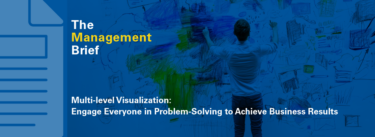This article is a follow-up from the co-authored story, “How Pall Corporation Accelerated the Covid-19 Vaccine Process Development Using Lean Thinking and Practice,” published concurrently on The Lean Post and Planet Lean in November 2020. The article shared how Pall Corp developed and deployed a complete manufacturing process in eight weeks – an 80% reduction compared to typical development times.
Before the pandemic, global demand for vaccines was 5 billion doses per year. This number included shots for the seasonal flu, measles, chickenpox, and more. Factoring in the much-needed Covid-19 vaccines, the new estimated global demand for all types of vaccines in 2021 is 19 billion doses – nearly four times the demand we experienced just two years ago.
This massive ramp-up of global capacity requires detailed coordination across the end-to-end value stream to ensure critical raw materials are available and bottlenecks are addressed while simultaneously scaling up new, potentially risky technologies. In this article, I explain how lean thinking and practice can help us succeed at this monumental undertaking.
There are two main challenges we need to address at this stage of fighting the pandemic.
Challenge #1: development and approval of an effective vaccine with high-volume process capability (complete and ongoing)
Before Covid-19, the record time to actually develop and gain approval for a vaccine was five years, which was for the Ebola vaccine developed by Merck. Before the Ebola vaccine, it would typically take 10 to 15 years for a vaccine to be developed and approved. It was not until 1945 that the first flu vaccine was licensed for civilian use in the United States – 27 years after the 1918 influenza pandemic.
The development and approval of the first Covid-19 vaccine happened in a record-shattering 11 months. Fifteen months into this pandemic, eleven vaccines are approved around the world, with more than 75 more going through clinical trials.
As outlined in the November 2020 article, companies like Pall Biotech of Danaher Corporation successfully contributed to this initial vaccine development challenge by using the lean principles and practices embedded in their organizational DNA.
Challenge #2: development and scale-up of global vaccine manufacturing capacity (in-progress)
From a process development standpoint, before Covid-19, the vaccine industry would take up to five years to build up enough manufacturing capacity across the supply chain to produce an actual vaccine. And it could take two years to transfer additional production to other contract manufacturer organizations (CMOs).
The Covid-19 vaccine end-to-end supply and manufacturing value streams are a complex chain of processes that span the entire globe. Over one hundred types of raw materials and components are necessary to produce and prepare a vaccine dose before it gets injected. Vaccine production processes have a long history of flows that are highly complicated and typically non-standardized.
The three high-level steps in the manufacturing of vaccines include upstream processing, downstream processing, and fill & finish. Upstream processing is where the cell culture is developed, grown, and harvested after being induced to produce the targeted drug substance. Downstream processing takes the drug substance and purifies it to a specific level via various techniques. The fill & finish step mixes the purified drug substance with other ingredients to create the actual vaccine, then doses the vaccine into vials, and finally packages the end product for shipment.
The majority of these manufacturing steps must occur in tightly controlled, clean-room environments that are highly regulated by government agencies. And these manufacturing steps take place at hundreds of CMO locations around the world, with thousands of quality control checkpoints throughout.
Risks and Gaps
In March 2021, UK think thank Chatham House co-sponsored the Covid-19 Vaccine Manufacturing and Supply Chain Summit, with participants from across the end-to-end supply networks. (Read a summary of the summit discussion document here.)
The summit highlighted numerous risks and gaps in the current vaccine supply and manufacturing landscape.
Total lead-time for a single batch from start to finish of manufacturing takes up to 120 days, which makes it difficult to ramp up quickly to meet increasing demand. With over 100 ingredients, components, and packaging materials necessary for vaccine production, if any materials or key quality data are missing or insufficient, entire in-process batches can be lost.
Critical equipment with very long lead-times to build and qualify is needed at several steps, with numerous technologies employed for the first time at high risk. Forecasting of equipment to procure is also highly chaotic. Vendors often receive an order from a CMO for new equipment that will consume months’ worth of vendor capacity to design, build, qualify, deliver, and install with little or no visibility to the order.
For the value stream’s upstream process, supply risks include bioreactor bags, single-use systems, and cell culture media. For the downstream process, there is a tight supply of filters and gamma sterilization. At fill & finish, glass vials remain a critical supply item due to boron constraints. There is a limited supply base to provide materials for a large part of the bill of materials for the vaccine (for example, one boron mine in California supplies 40% of glass vial manufacturers).
With regard to planning and human behavior, there is a tendency for our human-driven planning and forecasting systems to want higher inventory levels as a reaction to the uncertainties on the horizon and due to global trade issues. Inventory management is also highly variable – manufacturers are over-ordering and hoarding to protect their interest, especially on vital supplies such as glass vials.
So, where does lean thinking fit into this chaotic situation? This article describes how lean can help tackle the main difficulties we can encounter in the vaccine manufacturing process, grouped into three areas – output Improvement, flow management, and risk mitigation.
- Output Improvement: Increasing Process Capacity
Understanding the types of capacity
The first priority is to get an understanding of the capacity of each of the processes in the value stream. Capacity can be defined in many ways, but this discussion focuses on three types – planned capacity, actual capacity, and installed capacity.
For example, assume Process A has a planned run time of 16 hours per day and 100 parts per hour (36 seconds per part), factoring in calculated allowances for yield loss, changeover time, and other minor disruptions. Process A has a planned capacity of 1,600 parts per day. The actual capacity is the performance of the current process, which takes into account all the delays, yield losses, lost time, unused operating hours, and more. The daily performance of Process A is 1,200 parts per day (48 seconds per part) – the actual capacity, which is 75% of the planned capacity. In addition, the installed capacity of Process A, when we remove all the disruptions, is really 125 parts per hour (29 seconds per part) or 2,000 parts per day. Process A is therefore using 60% of its installed capacity.
Countermeasures for improving capacity
Once there is a better understanding of the capacity gaps by type, there are a handful of levers to pull to help increase output on existing processes, which typically increase in cost and time-to-benefit as you get lower down the list:
- Reduce the lost time on the existing process (increase efficiency = more output)
- Reduce the part-to-part cycle time on the existing process (increase capacity = more output)
- Add low-cost investment at the key bottleneck point (increase capacity with minor investment = more output)
- Re-configure another underused process for flexibility (flexible capacity with more investment = more output)
- Design and install a new flexible process (high capital spending = more output)
- Flow Management: Improving End-to-End Visibility and Reducing System Variability
Without close collaboration, frequent communication, and trust across the end-to-end value stream, the risk of demand amplification at each stage in the process is dangerously high. As demonstrated years ago by Jay Forrester at MIT and simulated in the classic Beer Game, the bullwhip effect must not be ignored in supply chain planning.
In the simulation and in real-life studies, demand forecasts at early processes in the end-to-end value stream may be over six times higher than the real consumer demand. Reasons for this bullwhip effect on the orders can be traced back to numerous factors, including rationing of orders, information delays, limited sharing of information, hoarding, batching rules, and more.
For the Covid-19 vaccine value stream, it will be essential for organizations to come together to create a shared visual dashboard of global capacity and critical supply planning to ensure that the right materials arrive in the right location at the right time. Think of this as a global obeya or visual management space. It does no good to have scarce glass vials reserved for an unproven vaccine in early clinical trials when an approved vaccine has a shortage of the same glass vials.
And the same logic applies to how critical long-lead-time equipment will be procured and installed for the production processes at the right place and at the right time. Many equipment vendors are already fully booked out for work through 2022, based on forecasts and uncertain vaccines. The industry cannot let all the uncertainty paralyze the execution by adding reckless management practices to the variability.
- Risk Mitigation: Managing New Process Innovation and Closing Knowledge Gaps
Covid-19 vaccine development has shed light on recent innovations and highlights opportunities for future innovation areas. The evolution of single-use systems in the past decade was a game-changer for the current environment that has dramatically improved the lead-time for vaccine processing, going from large-batch vessels with limited flexibility to smaller-lot disposable systems with mixed-substance capability.
From a materials standpoint, suppliers have also been working on alternatives to the traditional glass vials by developing vials that use less or none of the currently scarce boron. Some of the current vaccines can use these new vials, which puts less stress on the traditionally limited vial supply stream.
By leveraging the end-to-end dashboard and obeya of global supply and capacity, organizations will be able to identify processes that need innovation as a countermeasure to the current supply risks that exist. The supply risks can be ranked by magnitude, and then knowledge gaps identified for each risk. Once the knowledge gaps are understood and sequenced with prioritization, innovation ideas can be formulated and tested with prototypes for feasibility to close the gap.
Dealing with Future Uncertainty
The only thing that is certain in this Covid-19 vaccine manufacturing landscape is that there is a low degree of confidence in what will actually happen in the coming years regarding capacity and supply sources. Given this uncertainty, it will be paramount that the large pharmaceutical organizations improve transparency, focus, and collaboration across their end-to-end value streams while designing in flexibility to quickly shift and adapt to meet changing conditions. All of these are critical aspects of lean thinking and practice.





